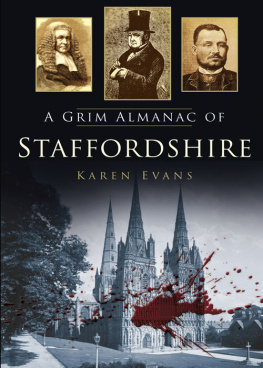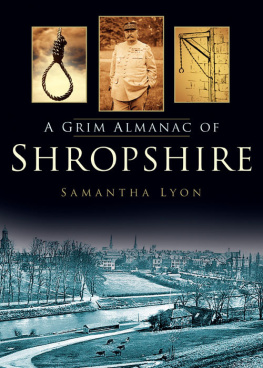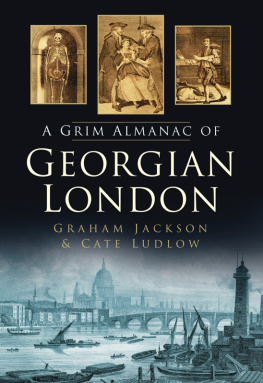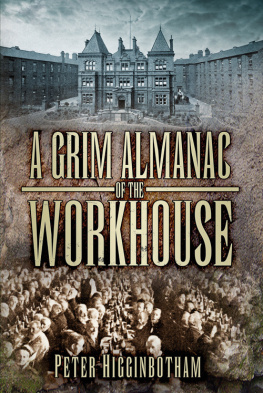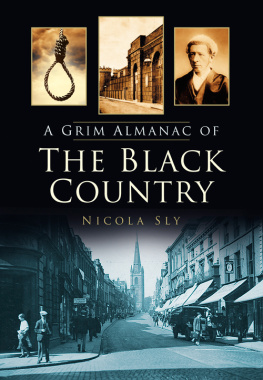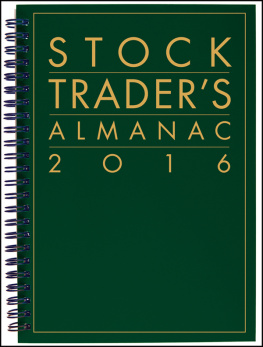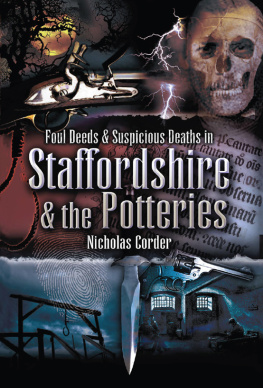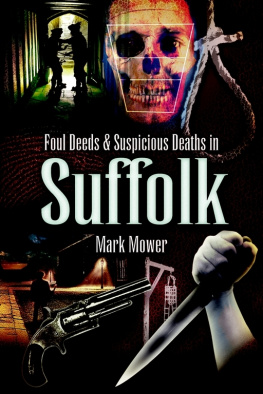

CONTENTS
All the grim events mentioned in this book are from contemporary newspaper accounts. Many of the stories differed greatly from one newspaper to the next, including name spellings, so these dark deeds are only as accurate as the accounts I used. When I began the book I was amazed at how unkind, wicked and downright evil people could be to one another and how dangerous the world was before health and safety! I am surprised so many ancestors lived to tell the tale.
I would like to thank the following for their contributions with information, illustrations and advice: Peter Higginbotham (www.workhouses.org.uk), Paul Swift (www.west-bromwich-photos.co.uk), Dennis Neale (www.blackcountrymuse.com), Adrian Harvey, Ken and Pat Upton. Those images which are uncredited have been provided by The History Press or taken from free or no-copyright sites. Thank you also to The History Press and particularly my editor Matilda Richards for all the help and encouragement. Much love as always to Pete, Imogen and Pierce for putting up with me over the last few months! Every effort has been made to clear copyright; however my apologies to anyone I might have inadvertently missed. I can assure you it was not deliberate but an oversight on my part.
Id like to dedicate this book to the memory of Liz Dangerfield, a great colleague and a true inspiration.
Karen Evans, 2014

JANUARY 1942 Sneyd Colliery in Burslem would not normally have been open on New Years Day but, with a war raging, the manager had appealed for workers and the men had responded. At approximately 7.50 that morning a loud explosion was heard at pit No. 4 which caused quake-like tremors to be felt on the surface. Workers and rescuers rushed to the scene where six men were found dead or dying near the pit bottom. Many more men and boys, however, were entombed behind the debris. At first there was hope that the trapped would be rescued alive, as there was no sign of fire, but within twenty-four hours three canaries taken down by the rescuers died from afterdamp (a toxic mixture of gases left after an explosion). Fifty-one bodies were recovered during the following week, the youngest aged sixteen and the oldest sixty-five. Many were married men with children; a Mrs Bennett lost both husband and son. At the inquest it was decided that six full coal tubs had broken free and run down the incline at some 40 miles an hour, pulling the empty up-coming rope and causing it to break. The resultant sparks then set the coal dust alight and caused the explosion.

Sneyd rescue team. (Courtesy of healeyhero)
JANUARY 1867 At about two oclock this morning Police Sergeant James Marriott was patrolling his beat in Newcastle-under-Lyme when he came upon a group of men singing Old John Barleycorn and knocking on doors in Merrial Street. Marriott, after ordering them to go home, left but returned shortly after to find Edward Tittensor, Richard Leech and Herbert Leech still causing a disturbance. Tittensor began to abuse the policeman but when Marriott went to arrest him, Richard Leech grabbed the policeman from behind and pulled them all to the floor. Once down Richard, Herbert and Edward all began kicking the sergeant in the face and body, striking him with a jug and swearing Give it the b; kill him before running away. The three assailants were quickly arrested and brought before Newcastle magistrates court later the same morning charged with assault where, in front of a much-bruised Police Sergeant Marriott, they were found guilty. Tittensor was fined twenty shillings and costs; Richard and Herbert were fined forty shillings each.
JANUARY 1845 Farmer Thomas Brough lived at New Brent Farm in Biddulph near Tunstall and, due to careful management, had been able to buy the nearby Whitefield Farm which he rented to his mother and brother, thirty-nine-year-old John Brough. On this Friday evening the bailiff visited John Brough for the 20 rent which was somewhat overdue, then sent for forty-eight-year-old Thomas when John complained, hoping that the situation could be sorted amicably. The two brothers were not seen to quarrel but Thomas complained about not being paid his rent and intimated he must have it, saying he would take away two boxes of clothing as collateral, which greatly upset their mother. When Thomas went to return home John said he would go with him as far as the barn and the brothers left together. When Thomas did not return home his wife became alarmed and took steps to locate him but it was not until noon the next day that the body of Thomas Brough was found in a sandpit on Biddulph Moor, his head smashed in with a blow from a hammer. John who was known for his calm and admirable temperament was questioned, whereupon he readily admitted to hitting his brother with a stone hammer after his entreaties to return the clothing had failed. He was sent before Mr Baron Platt at Staffordshire Assizes on 19 March 1845. The defence argued that it was a case of manslaughter but the jury returned a guilty verdict of wilful murder and John was sentenced to death. At noon on 5 April John Brough was led to the scaffold at Stafford Gaol and, watched by the assembled mob, was quickly dispatched. His body was then cut down and buried alongside the remains of other murders in the prison grounds.
JANUARY 1870 Today saw the inquest into the death of Thomas Plimley, a fifty-one-year-old potter from Burslem. On Tuesday, 28 December German Dean was driving his street railway car from Hanley to Burslem when Plimley alighted just after midday. German Dean later testified that it was Thomas custom to sit near the front of the car as he was a regular passenger. The day was frosty so German told everyone to hold on over the bumpy crossings, but otherwise the car was running smoothly. As they entered Cobridge, Thomas Plimley suddenly and without warning fell from the moving vehicle, crushing his arm under the car. Thomas was conveyed home where the seriously fractured arm was set. On Sunday, 3 January Dr Oldham removed the bandages and, finding that mortification had set in, he decided to amputate the arm in an attempt to save Plimleys life. Chloroform was administered but Thomas died within minutes. The jury at the inquest agreed with the doctor that exhaustion and potters asthma caused Plimleys death and returned a verdict in accordance with this evidence.
JANUARY 1871 Twenty-four-year-old puddler Elijah Moss of Campbells Flight, Dudley died this morning from injuries sustained at Messrs Plant and Fishers works, Dudley Port, Tipton on the previous night. Elijah unwittingly emptied red-hot cinders from his furnace into a small pool of water, causing steam and cinders to cover his entire body; his eyes were burnt from their sockets and part of his mouth was torn away by the intense heat and scoria (a type of rock made from molten metal). Moss, a married man with two small children, lingered for nearly twelve hours in complete agony before his death. The coroners inquest returned a verdict of accidental death.
JANUARY 1894 The continuing cold weather had caused the River Tame to freeze in Tamworth and on this Saturday afternoon several children were playing on the ice near Brewery Lane. Six-year-old Sarah Ann Elizabeth Lucas and her nine-year-old sister Florence Ada, who lived in New Street, Brewery Lane, ventured into the middle of the river when the ice suddenly gave way and both were precipitated into the water. A young boy ran to the girls mother Mrs Emily Lucas, who was at home with her son Henry, to alert her that, Flossy and Sally has tumbled into the water. Mrs Lucas and Henry rushed to the river where Henry was able to grab Florence by the hand but the current was too strong and she was swept away; he and his mother then also fell through the ice. Henry and Mrs Lucas were rescued but there was no sign of the girls. The police began dragging the river but Florences body was not found until Sunday evening and little Sarahs body was discovered downriver two days later. At the inquest it was made clear Mrs Lucas had warned her daughters not to play on the ice, but there was no way to stop children gaining access to the river if they wished. A verdict of accidental death was returned and the sympathy of the court passed to the unfortunate family.
Next page
